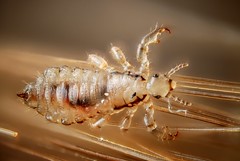Use the terms in this quizlet to help answer the questions in the community ecology packet.
| 6505749848 | Community | A group of interdependent organisms inhabiting the same region and interacting with each other |  | 0 |
| 6505749849 | Interspecific Interactions | interactions between 2 or more different types of species (includes competition, predation, herbivory, and symbiosis |  | 1 |
| 6505749850 | Symbiosis | the relation between two different species of organisms that are interdependent |  | 2 |
| 6505749851 | Competition | the struggle between organisms to survive in a habitat with limited resources |  | 3 |
| 6505749852 | Mutualism | symbiotic relationship in which both species benefit from the relationship. +/+ |  | 4 |
| 6505749853 | Commensalism | the relation between two different kinds of organisms when one receives benefits from the other without damaging it. +/0 |  | 5 |
| 6505749854 | Parasitism | a relationship between two species in which one species benefits and from the other species, which is harmed, involves a host |  | 6 |
| 6505749855 | Host | an animal or plant that nourishes and supports a parasite |  | 7 |
| 6505749856 | Parasite | an organism that lives in or on another organism; one who lives off another person |  | 8 |
| 6505749857 | Predation | an interaction in which one organism captures and feeds on another organism. +/- |  | 9 |
| 6505749858 | Interspecific Competition | in a community competition for limited resources between members of different species |  | 10 |
| 6505749859 | Competitive Exclusion | The concept that when populations of two similar species compete for the same limited resources, one population will use the resources more efficiently and have a reproductive advantage that will eventually lead to the elimination of the other population, This principle can be used to predict fundamental ecological niches |  | 11 |
| 6505749860 | Carrying Capacity | largest number of individuals of a population that a given environment can support |  | 12 |
| 6505749861 | Ecological Niche | the sum of a species' use of the biotic and abiotic resources in its environment. Like a "profession". |  | 13 |
| 6505749862 | Fundamental Niche | The full potential range of the physical, chemical, and biological factors a species can use if there is no competition from other species. |  | 14 |
| 6505749863 | Realized Niche | the range of resources and conditions a species actually uses or can tolerate at optimal efficiency; smaller than fundamental niche |  | 15 |
| 6505749864 | Resource Partitioning | The division of environmental resources by coexisting species such that the niche of each species differs by one or more significant factors from the niches of all coexisting species |  | 16 |
| 6505749866 | Cryptic Coloration | camouflage, , , makes potential prey difficult to spot against its background is a defensive mechanism. |  | 17 |
| 6505749867 | Aposematic Coloration | The bright coloration of animals with effective physical or chemical defenses that acts as a warning to predators (Posion Frogs) |  | 18 |
| 6505749868 | Batesian Mimicry | A type of mimicry in which a harmless species looks like a species that is poisonous or otherwise harmful to predators |  | 19 |
| 6505749869 | Mullerian Mimicry | evolution of two species both of which are unpalatable and have poisonous stingers or some other defense mechanism to resemble each other, leads into the gain of successive advantage . |  | 20 |
| 6505749871 | Endoparasites | parasites that live within the body of their host like roundworms |  | 21 |
| 6505749872 | Ectoparasites | Organisms, such as fleas, that live in the exterior of another organism (the host) and obtain food from it. |  | 22 |
| 6505749874 | Coevolution | the process in which species exert selective pressure on each other and gradually evolve new features or behaviors as a result of those pressures |  | 23 |
| 6505749875 | Keystone Species | a species that is critical to the functioning of the ecosystem in which it lives because it affects the survival and abundance of many other species in its community |  | 24 |
| 6505749876 | Invasive Species | plants and animals that have migrated to areas where they did not originate; often displace native species by outcompeting them for resources (exotic species) |  | 25 |
| 6505749877 | Ecological Succession | series of changes in the species in a community, often following a disturbance |  | 26 |
| 6505749878 | Primary Succession | an ecological succession that begins in a an area where no biotic community previously existed |  | 27 |
| 6505749879 | Secondary Succession | succession following a disturbance that destroys a community without destroying the soil. Yellowstone Fire in 1988 for example. |  | 28 |

